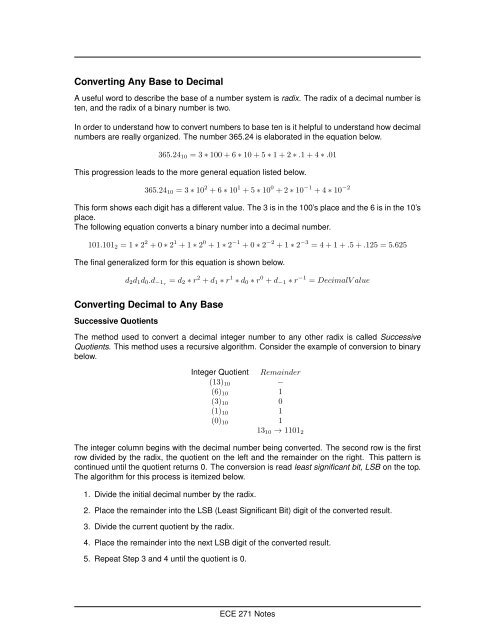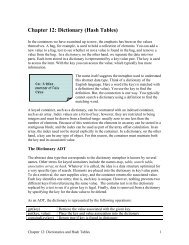Lecture 1: Digital Systems and Number Systems - Classes
Lecture 1: Digital Systems and Number Systems - Classes
Lecture 1: Digital Systems and Number Systems - Classes
Create successful ePaper yourself
Turn your PDF publications into a flip-book with our unique Google optimized e-Paper software.
Converting Any Base to Decimal<br />
A useful word to describe the base of a number system is radix. The radix of a decimal number is<br />
ten, <strong>and</strong> the radix of a binary number is two.<br />
In order to underst<strong>and</strong> how to convert numbers to base ten is it helpful to underst<strong>and</strong> how decimal<br />
numbers are really organized. The number 365.24 is elaborated in the equation below.<br />
365.24 10 = 3 ∗ 100 + 6 ∗ 10 + 5 ∗ 1 + 2 ∗ .1 + 4 ∗ .01<br />
This progression leads to the more general equation listed below.<br />
365.24 10 = 3 ∗ 10 2 + 6 ∗ 10 1 + 5 ∗ 10 0 + 2 ∗ 10 −1 + 4 ∗ 10 −2<br />
This form shows each digit has a different value. The 3 is in the 100’s place <strong>and</strong> the 6 is in the 10’s<br />
place.<br />
The following equation converts a binary number into a decimal number.<br />
101.101 2 = 1 ∗ 2 2 + 0 ∗ 2 1 + 1 ∗ 2 0 + 1 ∗ 2 −1 + 0 ∗ 2 −2 + 1 ∗ 2 −3 = 4 + 1 + .5 + .125 = 5.625<br />
The final generalized form for this equation is shown below.<br />
d 2 d 1 d 0 .d −1r = d 2 ∗ r 2 + d 1 ∗ r 1 ∗ d 0 ∗ r 0 + d −1 ∗ r −1 = DecimalV alue<br />
Converting Decimal to Any Base<br />
Successive Quotients<br />
The method used to convert a decimal integer number to any other radix is called Successive<br />
Quotients. This method uses a recursive algorithm. Consider the example of conversion to binary<br />
below.<br />
Integer Quotient Remainder<br />
(13) 10 −<br />
(6) 10 1<br />
(3) 10 0<br />
(1) 10 1<br />
(0) 10 1<br />
13 10 → 1101 2<br />
The integer column begins with the decimal number being converted. The second row is the first<br />
row divided by the radix, the quotient on the left <strong>and</strong> the remainder on the right. This pattern is<br />
continued until the quotient returns 0. The conversion is read least significant bit, LSB on the top.<br />
The algorithm for this process is itemized below.<br />
1. Divide the initial decimal number by the radix.<br />
2. Place the remainder into the LSB (Least Significant Bit) digit of the converted result.<br />
3. Divide the current quotient by the radix.<br />
4. Place the remainder into the next LSB digit of the converted result.<br />
5. Repeat Step 3 <strong>and</strong> 4 until the quotient is 0.<br />
ECE 271 Notes

















